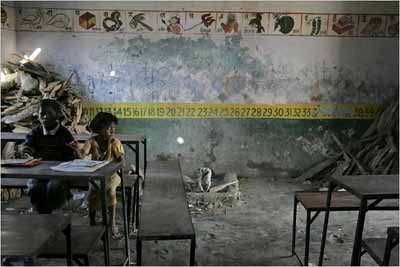The introduction is quite strong -- it's a helpful foray into the issues one has to contend with when thinking about "vernacular literatures" from around the post-colonial world. Ahmad brings together everything from Macaulay's "Minute on Education" to the responses by postcolonial writers like Chinua Achebe, who were at first somewhat ambivalent about writing in English (though Achebe more than adequately defended the idea of African fiction in English in his essay "The African Writer and the English Language," also included in this volume).
Ahmad also makes the intriguing choice to include African-American vernacular writers (Charles Chesnutt, Langston Hughes) as well as writing by Scottish (Robert Burns, Irvine Welsh) and Irish (Roddy Doyle) vernacular writers in the anthology. The great advantage of this is the way it suggests that "Rotten English" is not necessarily a new movement, per se, or strictly limited to "postcolonial" concerns. But such inclusiveness also raises a question of historical relevance: what does it really mean to link a poet like Robert Burns to, say, Louise Bennett?
[UPDATED in DECEMBER 2009: In fact, the historical circumstances that lead Bennett to emphatically proclaim her affinity for Jamaican patois ("Dah language weh yuh proud o’,/Weh yu honour and respeck,” but, at the same time, the truth is “Dat it it spring from dialect!”) are actually similar, even across a significant historical divide, to the aesthetic and political framework that produced Burns.
In fact, one could very well use this anthology while focusing specifically on the strictly "postcolonial" authors -- Oonya Kempadoo, Derek Walcott, and Louise Bennett. Or it could be used with a broader historical lens. Some of the passionate feelings about language experienced felt by today's postcolonial writers were also alive for Irish writers 100 years ago, and for Scottish writers like Burns more than 200 years ago!]
*
I've been very interested to learn about some of the authors I was previously unfamiliar with in Ahmad's anthology, like the Northern Irish writer Frances Molloy, or the Papaua New Guinean John Kasaipwalova.
Rereading the excerpt of Gautam Malkani's Londonstani Ahmad has included reminded me just why I disliked that novel -- I can't really sympathize with, or even be very interested in, Malkani's Brit-Punjabi thugs. But I'm also not really convinced by the particular vernacular spoken by Malkani's characters; they seem to be trying too hard. One of the worst moments for me is this paragraph:
All a this shit was just academic a course. Firstly, Hardjit's thesis, though it was what Mr Ashwood's call internally coherent, failed to recognize the universality a the word Nigga compared with the word Paki. De-poncified, this means many Hindus an Sikhs'd spit blood if they ever got linked to any thing to do with Pakistan. Indians are just too racist to use the word Paki.
Here, as elsewhere in his novel, Malkani is pursuing some interesting lines of thought regarding problems of self-naming within the Desi diaspora. But it's simply not realistic that Malkani's characters would work through these questions in a vernacular idiom; I would rather expect them to code-switch between academic (sociological) terms in standard English, and their Punjabi and Jamaican patois-inflected street language, when lusting after Nike Air Force Ones and beating up "goras" who use the word "Paki."
Much better than Malkani is Rohinton Mistry, whose "The Ghost of Firozsha Baag" is one of my favorite short stories from Mistry's earlier work:
All the fault is of old bai who died ten years ago. She was in charge till her son brought a wife, the new bai of the house. Old bai took English words and made them from Parsi words. Easy chair was igeechur, French beans was ferach beech and Jacqueline became Jaakaylee. Later I found out that all old Parsis did this, it was like they made their own private language.
So then new bai called me Jaakaylee also, and children do the same. I don't care about it now. If someone asks my name I say Jaakaylee. And I talk Parsi-Gujarati all the time instead of Konkani, even with other ayah.s Sometimes also little bits of English.
*
While I'm being critical, I might also point readers to Evelyn Ch'ien's "Weird English" (also at "Politics & Culture"), which runs along the same lines as her recent book of the same title. I may have my issues with the rather broad scope of "Rotten English," but at least it has a very strong historical and intellectual justification in Ken Saro-Wiwa's novel (Sozaboy: A Novel in Rotten English). By contrast, calling the same body of writing (with some variations) "Weird English" doesn't do much for me -- largely because I don't like the word "weird." "Rotten English" can work as a subversive rallying cry for accented and vernacular speakers of English all over the world (though I think "Global English" is more denotatively accurate, if blander). "Weird English," by contrast, really doesn't have the same purchase.
